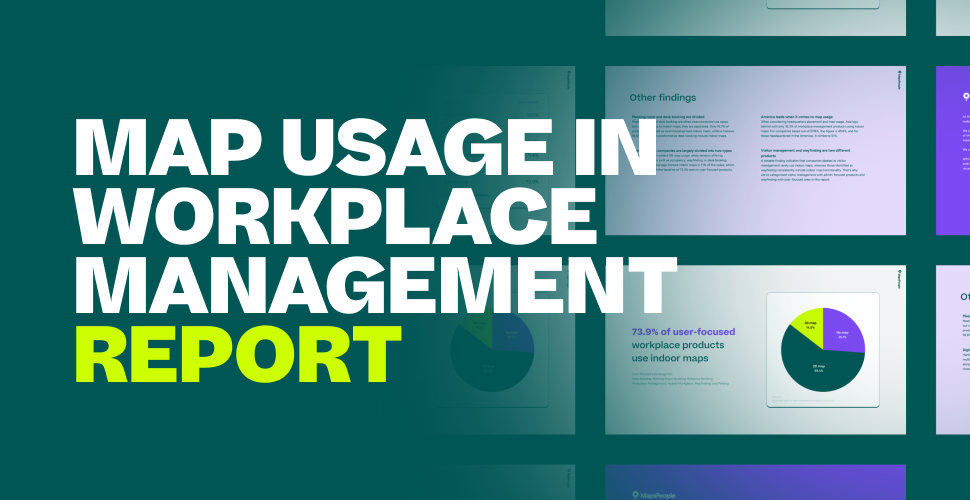“Indoor maps are essential for being competitive in workplace management.”
This is the conclusion of a recent analysis of 393 companies within the workplace management space.
In this blog post, we dive into the findings to show you why workplace products need an indoor map to keep their competitive edge.
73.9% of user-focused workplace products use indoor maps -4.png?width=400&height=400&name=image%20(2)-4.png)
A staggering 73.9% of user-focused* workplace solutions have an indoor map, leaving only 26.1% without.
Standing out from the crowd is usually a good thing, but in this case, it’s not.
Picture this: you're tasked with choosing between two desk booking options - one shows available desks in a list view, while the other visualizes them on an interactive map. Which would you choose?
If you’re like most people, you’d go with the one with the map.
Indoor maps are non-negotiable in user-focused workplace solutions because they enhance the user experience - and user experience is key.
Companies increasingly turn to user experience panels to vet new software solutions. If your solution doesn't pass muster with the panel, you're out of the game. Companies understand that subpar user experience leads to low user adoption rates, increasing the risk of them wasting money on new software.
(*User-focused subcategories include Desk Booking, Meeting Room Booking, Resource Booking, Workplace Management, Hybrid Workplace, Wayfinding, and Parking.)
100% of hybrid workplace solutions have indoor maps
Zooming in on the user-focused subcategories shows that 100% of Hybrid Workplace solutions have an indoor map. The same goes for 78.1% of Workplace Management solutions and 71.4% of Parking solutions.
These adoption rates prove that indoor maps are becoming a key component of user-focus workplace products.
The research also shows that 59.4% of user-focused workplace products use 2D maps and 14.5% use 3D maps.
Indoor 3D maps are a newer feature that enhances user experience. While they will become more popular, they won't replace 2D maps entirely. Instead, users will be able to switch between 2D and 3D based on their preferences in the future, much like they can on any outdoor map.
36.1% of admin-focused workplace products have an indoor map -Apr-12-2024-11-45-04-6044-AM.png?width=400&height=400&name=image%20(1)-Apr-12-2024-11-45-04-6044-AM.png)
Only 36.1% of admin-focused workplace products have indoor maps, compared to the majority of user-focused ones. When we look closer, we see that certain admin-focused categories, like Space Management (72.4%), are more likely to include maps, while others, like Facility Management (28.1%), are less likely.
Integrated workplace management systems (IWMSs) are significantly more likely (58.3%) to have maps compared to facility management systems. This is because IWMSs often have many users and may come with mobile apps that need maps to depict desks and other user-interactable elements.
(*Admin-focused subcategories: Occupancy, Security, Access, Location Intelligence, IWMS, Facility Management, Space Management, Property Management, CMMS, Asset Management, and Visitor Management.)
Desk booking solutions are more likely to include a map compared to room booking solutions
 Another interesting finding is that desk booking solutions are far more likely to have a map than room booking solutions. 92.6% of desk booking solutions have a map, while the same applies to only 16.7% of room booking solutions.
Another interesting finding is that desk booking solutions are far more likely to have a map than room booking solutions. 92.6% of desk booking solutions have a map, while the same applies to only 16.7% of room booking solutions.
Navigating an office to find a meeting room can be just as challenging as securing a desk. However, while people usually book a desk for the entire day, they might move around to multiple meetings across different rooms throughout the building. So, why the gap?
Desk booking solutions have gained popularity with the adoption of hybrid work, where employees only come into the office a couple of times a week and may not be very familiar with the office layout. This makes it important for them to be able to both see and book available desks and locate them.
Room booking solutions, on the other hand, have been around longer when people came in every day, knew the office, and just needed to secure a room for their meetings. This means that while many desk booking solutions are built with a map, room booking solutions have to integrate one, making them lag behind.
If you want the full report, click the button below or follow this link.
April 12, 2024




.png)